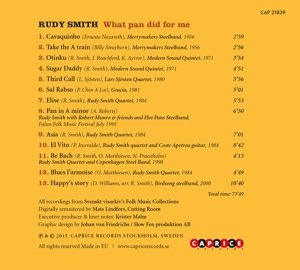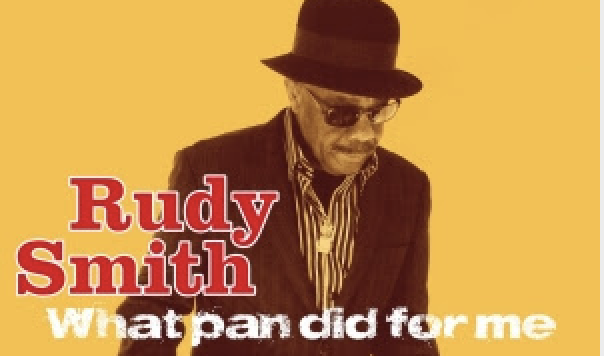In the nearly 80 years since biscuit tins were converted into the first steelpan instruments, there have been many masters of the art form to emerge. Most have made names for themselves through original compositions, virtuoso performances and classic arrangements for steelband. But few can say that not only have they done all those things, but have captured them all on recordings to share with the world in a compilation CD at the twilight of their careers.
Given the limited options available on the market for books that document the history of steelpan, it’s a rare feat to find not only an album that chronicles the history of steelpan music, but includes a tell-all booklet written by the artist of said album. Enter Rudy “Twoleft” Smith who has been playing, arranging for, and building pan since the 1950s.
The Trinidadian native has had an epic career that has spanned the decades, musical genres and the globe. His latest album, “What pan did for me,” was released by Swedish company, Caprice Records. It features 13 tracks that include his early work with the Merrymakers Steelband, various jazz combos, and steelbands from different parts of the world, including Trinidadian band birdsong Steel Orchestra as Panorama arranger for nine straight years in the 2000s.
The opening track is an Ernesto Nazareth composition called Cavaquinho, which shares the same name of the Portuguese instrument. The playful song was performed in 1956 by Merrymakers Steelband, a group that Smith joined when he was just eight years old. He was 12 at the time of the recording and already a senior member of the group, as he described in the album’s booklet narration.
The second track, swing time classic, “Take The A Train,” also featured the Merrymakers’ 1956 lineup. There are several noteworthy items in these tracks. The sound quality is surprisingly good, which likely is a result of modern technology helping to maximize the orchestra’s instrument balance. The musicianship is also stellar, featuring particular virtuosity in the melody pans. Finally, the pans themselves, although they predate the inclusion of heat in the pan building process and are still in the ping pong pan state, are well-tuned and add both a fresh and nostalgic feel for any listener.
As the album and narration booklet continue, they compliment one another, taking the listener on a journey that would not normally be supported considering the nature of instrumental music not including words. Thanks to Smith’s clear and concise storytelling, it’s clear who he’s playing with, when they recorded each track and what each group was going for.
The fusion piece “Otinku,” allows listeners to hear a variety of percussion and a musical styles, including African, caribbean, jazz and funk. The music is indicative to the time it was recorded in 1971 when jazz fusion was all the rage. 

“Third Call” was written by Lars Sjosten and performed by the Lars Sjosten Quartet and features Smith prominently in the opening, outlining chords. The piece takes shape as a bossa nova-esque groove that features tastefully executed solos on both piano and steelpan by Smith. The next track, continues with the Latin jazz vibe with a bevy of percussion instruments jamming to a fast-paced salsa piece called “Sal Rabso.”
The back end of the album features two welcome surprises embedded in more rock-solid jazz from Sweden. The first of note is a unique version of “Pan in A Minor” that features Smith performing with famed Trinidadian parang player, Robert Munro, and Hot Pans steelband from Sweden. Smith, who considers himself a pioneer in bringing pan to Scandinavian countries like Sweden, Switzerland and Finland, arranged for Hot Pans beginning in 1984. The recording, which took place at the Falun (Sweden) Folk Music Festival in July of 1995, was live for the Swedish crowd, and offers a beautiful opening and closing that features the parang and steelpan together, soloing over the changes of the piece.
The second song worth noting is “Be Bach,” an original composition by Smith, Ole Matthiesen (piano) and Niels Prastholm (bass). The piece is written in the style of classical composer, Johann Sebastian Bach, and seemlessly blends piano, a steelpan orchestra (Copenhagen Steel Band) and Smith’s steelpan solos into a fusion of classical and jazz.
After the well-composed track “Blues l’armoise,” the album ends on its only Panorama composition, “Happy’s Story,” which Smith arranged for birdsong Steel Orchestra in 2000. As you listen to the piece, which tops out at 10 minutes and 40 seconds in length, it becomes clear why Smith chose it to end the album. It’s the perfect summation for his musical style and how his mind works as an arranger. “Arranging for a band is like playing jazz. You never know who you’re going to meet so you’ve got to improvise all the time,” Smith said on page 41 of his notation booklet. “You have to make the arrangement to suit what they can do and that’s what I do all the time.”
Perhaps the most jaw-dropping aspect of this compilation album is how complete it is. For some artists, their compilation is merely a musical summation of their life’s work, which needs no explanation, depending on the artist’s popularity. But since steelpan artists aren’t as well known in the world as they deserve to be, having the narration booklet with historical photos as a guide to both Smith’s life and musical journey, supports the album perfectly for the listener. It even comes complete with terminology at the end to explain the meanings of some of the terms Smith used in his narration, such as Badjohn (a rude person) and Jouve (the opening of carnival). Smith ends his narration with some advice that every pannist, musician and person reading can take note of thanks to its honesty and directness.
“What I like to say is that all who take up playing pan I would like them to take it serious and take the same approach to pan, the same level of dedication, as if you play the guitar or piano. Apply the same thing to the pan and you will get good results,” Smith said. “And play what you want to play. Pan is just another instrument.”
The album can be purchased on Amazon.com as both a physical or digital copy. It’s also available on iTunes. Visit Caprice Records’ website for more information on Smith and his album.









Great pan solist. I have almost all of Two Left’s music and I will be getting this one. I wish Two Left all the best as he celebrates his life in pan. He is a friend.